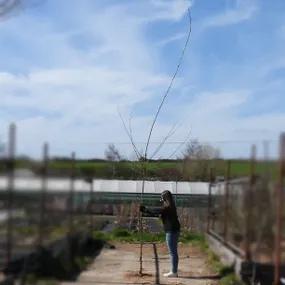Balsam Spire Poplar Trees
Honest Delivery Prices- Vigorous
- Good for screening and shelter belts
- Balsam scented foliage
- Slender, upright habit.
- Bareroot Delivery: Nov-March.
Recommended extras
Description
Populus Balsamspire Standard Trees
A slender, upright tree with thin branches, Balsam Poplar is grown chiefly for its delicious scent, which is strongest in spring, just before the leaves unfurl. The heart-shaped leaves are quite large and soft, with a pale green underside, and turn a modest yellow in autumn. Populus balsamifera has a strong suckering habit and tends to form a thicket of small stems around its base - excellent for wildlife but a bit of chore if you want to keep them cut back. The bark provides some interest, with its pattern of diagonal, cross-hatched ridges. The flowers are barely visible and the seeds are likewise small and simple - this is really a tree for the nose, rather than the eyes, to admire. The canopy is fairly sparse and does not cast dense shade, which is good for a smaller garden where sunlight is more precious, though the suckers can be a little invasive. This tree was introduced from North America in the 1680's and was known by its Native American name tacamahaca or tacamahac for some time (personally, I would have kept it that way). It is now often referred to as Balsamspire.
These trees are really fast growing and, like all the upright poplars, are ideal screening trees.
Browse our variety of large garden trees or our full range of trees.
Growing Balsam Poplar
A relative of willow, Populus balsamifera is right at home in wet soil near a river or lake and will tolerate the odd flood. It is not a very big tree and doesn't spread much, so you should not need to prune it and doing so will only make it sucker even more (if you cut down a mature tree and leave the roots alone, there will be a small forest of suckers the next year). They like a rich soil, good sun and detest chalk. If you have to prune a stray branch, do it in winter. An adult tree will grow to about 20 metres, 65 feet.
How Standard Trees are Measured:
All the plants in the ornamental trees section are graded as standardss, which means that they are measured by their girth in centimetres 1 metre above ground level (basically, their trunk's waist measurement). They aren't measured by their height, which will vary.
So, a 6/8 standard has a trunk with a circumference of 6-8 centimetres and an 8/10 standard has a trunk 8-10 centimetres around.
This measurement makes no difference to the tree's final height. Most standards are between 2 - 3.5 metres tall, but this is just an average. We cannot tell you how tall your trees will be before we deliver them.
Planting Instructions
Please watch our tree planting video for full planting instructions.




